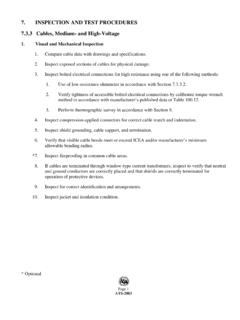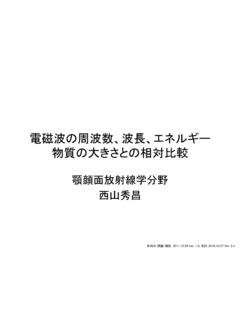Transcription of CHAPTER TRANSMISSION MEDIA - INTRANET
1 4/5/03 10:54 AM Page 93. CHAPTER 4. TRANSMISSION MEDIA . Guided TRANSMISSION MEDIA Twisted Pair Coaxial Cable Optical Fiber Wireless TRANSMISSION Antennas Terrestrial Microwave Satellite Microwave Broadcast Radio Infrared Wireless Propagation Ground Wave Propagation Sky Wave Propagation Line-of-Sight Propagation Line-of-Sight TRANSMISSION Free Space Loss Atmospheric Absorption Multipath Refraction Recommended Reading and Web Sites Key Terms, Review Questions, and Problems Key Terms Review Questions Problems 4/5/03 10:54 AM Page 94. 94 CHAPTER 4 / TRANSMISSION MEDIA . KEY POINTS. The TRANSMISSION MEDIA that are used to convey information can be classi- fied as guided or unguided. Guided MEDIA provide a physical path along which the signals are propagated; these include twisted pair, coaxial cable, and optical fiber.
2 Unguided MEDIA employ an antenna for transmitting through air, vacuum, or water. Traditionally, twisted pair has been the workhorse for communications of all sorts. Higher data rates over longer distances can be achieved with coax- ial cable, and so coaxial cable has often been used for high-speed local area network and for high-capacity long-distance trunk applications. However, the tremendous capacity of optical fiber has made that medium more attrac- tive than coaxial cable, and thus optical fiber has taken over much of the market for high-speed LANs and for long-distance applications. Unguided TRANSMISSION techniques commonly used for information com- munications include broadcast radio, terrestrial microwave, and satellite.
3 Infrared TRANSMISSION is used in some LAN applications. In a data TRANSMISSION system, the TRANSMISSION medium is the physical path between transmitter and receiver. Recall from CHAPTER 3 that for guided MEDIA , electromag- netic waves are guided along a solid medium, such as copper twisted pair, copper coaxial cable, and optical fiber. For unguided MEDIA , wireless TRANSMISSION occurs through the atmosphere, outer space, or water. The characteristics and quality of a data TRANSMISSION are determined both by the characteristics of the medium and the characteristics of the signal. In the case of guided MEDIA , the medium itself is more important in determining the limitations of TRANSMISSION . For unguided MEDIA , the bandwidth of the signal produced by the transmitting antenna is more important than the medium in determining TRANSMISSION character- istics.
4 One key property of signals transmitted by antenna is directionality. In gener- al, signals at lower frequencies are omnidirectional; that is, the signal propagates in all directions from the antenna. At higher frequencies, it is possible to focus the sig- nal into a directional beam. In considering the design of data TRANSMISSION systems, key concerns are data rate and distance: the greater the data rate and distance the better. A number of de- sign factors relating to the TRANSMISSION medium and the signal determine the data rate and distance: Bandwidth: All other factors remaining constant, the greater the bandwidth of a signal, the higher the data rate that can be achieved. TRANSMISSION impairments: Impairments, such as attenuation, limit the dis- tance.
5 For guided MEDIA , twisted pair generally suffers more impairment than coaxial cable, which in turn suffers more than optical fiber. Interference: Interference from competing signals in overlapping frequency bands can distort or wipe out a signal. Interference is of particular concern for unguided MEDIA but is also a problem with guided MEDIA . For guided MEDIA , 4/5/03 10:54 AM Page 95. / GUIDED TRANSMISSION MEDIA 95. Frequency 2 3 4 5 6 7 8 9 10 11 12 13 14 15. (Hertz) 10 10 10 10 10 10 10 10 10 10 10 10 10 10. ELF VF VLF LF MF HF VHF UHF SHF EHF. Power and telephone Radio Microwave Infrared Visible Rotating generators Radios and televisions Radar Lasers light Musical instruments Electronic tubes Microwave antennas Guided missiles Voice microphones Integrated circuits Magnetrons Rangefinders Twisted pair Optical fiber Coaxial cable AM radio FM radio Terrestrial and TV and satellite TRANSMISSION Wavelength 6 5 4 3 2 1 0 1 2 3 4 5 6.
6 10 10 10 10 10 10 10 10 10 10 10 10 10. in space (meters). ELF Extremely low frequency MF Medium frequency UHF Ultrahigh frequency VF Voice frequency HF High frequency SHF Superhigh frequency VLF Very low frequency VHF Very high frequency EHF Extremely high frequency LF Low frequency Figure Electromagnetic Spectrum for Telecommunications interference can be caused by emanations from nearby cables. For example, twisted pairs are often bundled together and conduits often carry multiple cables. Interference can also be experienced from unguided transmissions . Proper shielding of a guided medium can minimize this problem. Number of receivers: A guided medium can be used to construct a point-to- point link or a shared link with multiple attachments.
7 In the latter case, each attachment introduces some attenuation and distortion on the line, limiting distance and/or data rate. Figure depicts the electromagnetic spectrum and indicates the frequencies at which various guided MEDIA and unguided TRANSMISSION techniques operate. In this CHAPTER we examine these guided and unguided alternatives. In all cases, we de- scribe the systems physically, briefly discuss applications, and summarize key trans- mission characteristics. GUIDED TRANSMISSION MEDIA . For guided TRANSMISSION MEDIA , the TRANSMISSION capacity, in terms of either data rate or bandwidth, depends critically on the distance and on whether the medium is point-to-point or multipoint. Table indicates the characteristics typical for the common guided MEDIA for long-distance point-to-point applications; we defer a dis- cussion of the use of these MEDIA for multipoint LANs to Part Four.
8 4/5/03 10:54 AM Page 96. 96 CHAPTER 4 / TRANSMISSION MEDIA . Table Point-to-Point TRANSMISSION Characteristics of Guided MEDIA [GLOV98]. Frequency Typical Typical Repeater Range Attenuation Delay Spacing Twisted pair 0 to kHz dB>km @ 1kHz 50 s>km 2 km (with loading). Twisted pairs 0 to 1 MHz 3 dB>km @ 1kHz 5 s>km 2 km (multi-pair cables). Coaxial cable 0 to 500 MHz 7 dB>km @ 10 MHz 4 s>km 1 to 9 km Optical fiber 180 to 370 THz to dB>km 5 s>km 40 km 12. THz = TeraHerz = 10 Hz. The three guided MEDIA commonly used for data TRANSMISSION are twisted pair, coaxial cable, and optical fiber (Figure ). We examine each of these in turn. Twisted Pair The least expensive and most widely used guided TRANSMISSION medium is twisted pair.
9 Physical Description A twisted pair consists of two insulated copper wires arranged in a regular spi- ral pattern. A wire pair acts as a single communication link. Typically, a number of these pairs are bundled together into a cable by wrapping them in a tough protec- tive sheath. Over longer distances, cables may contain hundreds of pairs. The twist- ing tends to decrease the crosstalk interference between adjacent pairs in a cable. Neighboring pairs in a bundle typically have somewhat different twist lengths to re- duce the crosstalk interference. On long-distance links, the twist length typically varies from 5 to 15 cm. The wires in a pair have thicknesses of from to mm. Applications By far the most common TRANSMISSION medium for both analog and digital sig- nals is twisted pair.
10 It is the most commonly used medium in the telephone network and is the workhorse for communications within buildings. In the telephone system, individual residential telephone sets are connected to the local telephone exchange, or end office, by twisted-pair wire. These are re- ferred to as subscriber loops. Within an office building, each telephone is also con- nected to a twisted pair, which goes to the in-house private branch exchange (PBX). system or to a Centrex facility at the end office. These twisted-pair installations were designed to support voice traffic using analog signaling. However, by means of a modem, these facilities can handle digital data traffic at modest data rates. Twisted pair is also the most common medium used for digital signaling.






